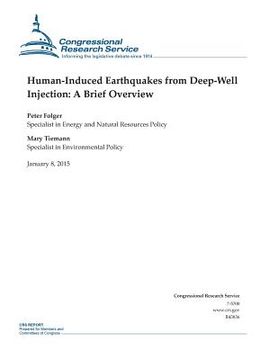Reseña del libro "Human-Induced Earthquakes from Deep-Well Injection: A Brief Overview (en Inglés)"
The development of unconventional oil and natural gas resources using horizontal drilling and hydraulic fracturing (fracking) has created new demand for wastewater disposal wells that inject waste fluids into deep geologic strata. An increasing concern in the United States is that injection of these fluids may be responsible for increasing rates of seismic activity. The number of earthquakes of magnitude 3.0 or greater in the central and eastern United States has increased dramatically since about 2009, from an average of approximately 20 per year between 1970 and 2000 to over 100 per year in the period 2010-2013. Some of these earthquakes may be felt at the surface. For example, 20 earthquakes of magnitudes 4.0 to 4.8 have struck central Oklahoma since 2009. The largest earthquake in Oklahoma history (magnitude 5.6) occurred on November 5, 2011, near Prague, causing damage to several structures nearby. Central and northern Oklahoma were seismically active regions before the recent increase in the volume of waste fluid injection through deep wells. However, the recent earthquake swarm does not seem to be due to typical, random, changes in the rate of seismicity, according to the U.S. Geological Survey. The relationship between earthquake activity and the timing of injection, the amount and rate of fluid injected, and other factors are still uncertain and are current research topics. Despite increasing evidence linking some deep-well disposal activities with human-induced earthquakes, only a small fraction of the more than 30,000 U.S. wastewater disposal wells appears to be associated with damaging earthquakes. The potential for damaging earthquakes caused by hydraulic fracturing itself, as opposed to deep-well injection of wastewater from oil and gas activities, appears to be much smaller. Hydraulic fracturing intentionally creates fractures in rocks, and induces microseismicity, mostly of less than magnitude 1.0, too small to feel or cause damage. In a few cases, however, fracking has led directly to earthquakes larger than magnitude 2.0, including at sites in Oklahoma, Ohio, England, and Canada. The Environmental Protection Agency's (EPA's) Underground Injection Control (UIC) program under the Safe Drinking Water Act (SDWA) regulates the subsurface injection of fluids to prevent endangerment of drinking water sources. EPA has established regulations for six classes of injection wells, including Class II wells used for the injection of fluids for enhanced oil and gas recovery and wastewater disposal. Most oil and gas states administer the UIC Class II program. The SDWA does not address seismicity, although EPA regulations for certain classes of injection wells require some evaluation of seismic risk. Such requirements do not apply to Class II wells; however, EPA has developed a framework for evaluating seismic risk when reviewing Class II permit applications in states where EPA administers this program. How Congress shapes EPA or other agency efforts to address and possibly mitigate human-caused earthquakes may be an issue in the 114th Congress. In 2011, in response to seismic events in Arkansas and Texas thought to be associated with wastewater disposal wells, EPA authorized a national UIC technical work group to develop recommendations to address the risk of Class II disposal-induced seismicity. EPA plans to issue a document outlining technical recommendations and best practices in early 2015. At the state level, several states have increased oversight of Class II wells in response to induced seismicity concerns. In 2014, state oil and gas and groundwater protection agencies established a work group to discuss Class II disposal wells and recent seismic events occurring in multiple states.

